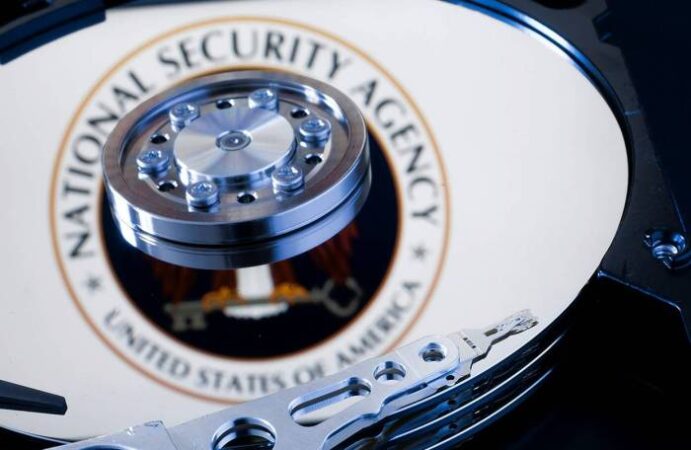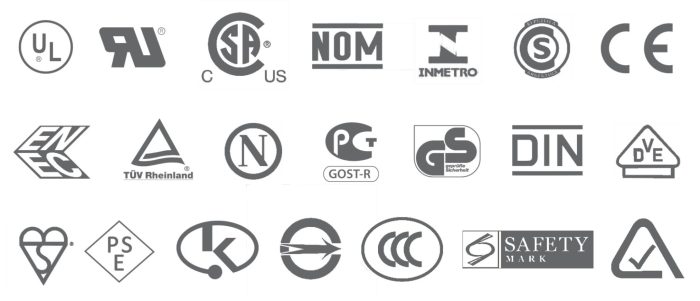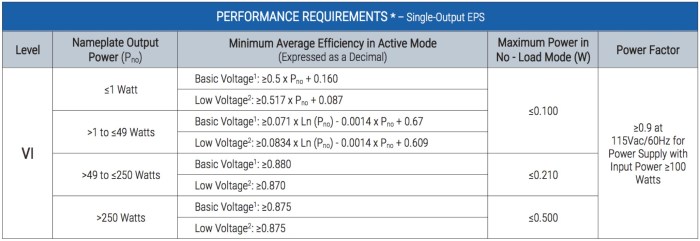
- Introduction to Power Supply Regulations and Standards
- Key Aspects of Power Supply Regulations and Standards
- Impact of Power Supply Regulations on Device Design and Manufacturing
- Emerging Trends in Power Supply Regulations and Standards
- Case Studies of Power Supply Regulations and Standards in Action
- Power Supply Regulations and Standards
- Ending Remarks
- FAQs
Imagine a world without consistent power, where devices malfunction, and safety is compromised. Power supply regulations and standards are the invisible guardians of our technological world, ensuring the safe and reliable operation of everything from smartphones to industrial machinery.
These regulations establish a framework for voltage, frequency, current, and other critical parameters, guaranteeing compatibility and preventing catastrophic failures. They also address safety concerns, such as electrical shock and electromagnetic interference, safeguarding both users and equipment. This comprehensive guide explores the multifaceted world of power supply regulations and standards, delving into their impact on device design, global harmonization efforts, and the future of power distribution.
Introduction to Power Supply Regulations and Standards

Power supply regulations and standards are crucial for ensuring the safe, reliable, and efficient operation of electrical systems. They establish guidelines and requirements for the design, manufacture, installation, and operation of power supplies, encompassing various aspects such as voltage levels, frequency, safety protocols, and compatibility.
These regulations and standards play a vital role in safeguarding both people and property from electrical hazards, promoting interoperability between different devices and systems, and facilitating the smooth functioning of power grids. They also ensure that power supplies meet specific performance requirements, such as efficiency and reliability, which contribute to energy conservation and cost optimization.
Regulatory Bodies and Standardization Organizations
Regulatory bodies and standardization organizations play a pivotal role in developing, implementing, and enforcing power supply regulations and standards. These entities bring together experts from various industries, governments, and research institutions to establish consensus-based guidelines that are widely accepted and adopted globally.
Here are some prominent international and national organizations involved in power supply standardization:
- International Electrotechnical Commission (IEC): The IEC is a global organization that develops international standards for electrical and electronic technologies, including power supply systems. It collaborates with national standardization bodies worldwide to ensure consistency and harmonization of standards.
- International Organization for Standardization (ISO): The ISO is another global organization that develops standards for a wide range of products and services, including power supply systems. Its standards are widely recognized and adopted by businesses and governments around the world.
- National Electrical Manufacturers Association (NEMA): NEMA is a US-based organization that develops and promotes standards for electrical equipment, including power supplies. Its standards are widely used in North America and other parts of the world.
- Underwriters Laboratories (UL): UL is a global safety science company that provides safety testing and certification services for various products, including power supplies. Its certification marks are widely recognized as a symbol of safety and reliability.
Key Aspects of Power Supply Regulations and Standards
Power supply regulations and standards play a crucial role in ensuring the safe and reliable operation of electrical systems. These standards define essential parameters, address safety concerns, and establish guidelines for compatibility and interoperability.
Electrical Parameters
Power supply standards define critical parameters that govern the electrical characteristics of power systems. These parameters ensure compatibility and prevent damage to equipment.
- Voltage: Standards specify the nominal voltage levels for different power systems, such as 120V, 240V, or 480V. These voltage levels are essential for proper operation of electrical appliances and equipment.
- Frequency: Power supply standards define the frequency of alternating current (AC) power, typically 50 Hz or 60 Hz. Frequency affects the speed of motors and the performance of other AC devices.
- Current: Standards specify the maximum current that can be drawn from a power source. This parameter helps prevent overloading and overheating of circuits and equipment.
- Power Factor: Power factor measures the efficiency of electrical power usage. Standards encourage power factor correction techniques to improve efficiency and reduce energy losses.
Safety Considerations
Power supply regulations and standards prioritize safety by addressing potential hazards associated with electricity.
- Electrical Shock: Standards define insulation requirements for electrical equipment and wiring to prevent electric shock hazards. Grounding and fault protection mechanisms are essential for safety.
- Fire Hazards: Standards address fire hazards by specifying wire gauge, fuse ratings, and circuit breaker sizes to prevent overheating and potential fires.
- Electromagnetic Interference (EMI): Standards set limits on electromagnetic emissions from electrical equipment to prevent interference with other devices and systems.
Comparison of Standards
Different power supply standards exist worldwide, each with specific requirements and regulations.
- IEC (International Electrotechnical Commission) Standards: IEC standards are widely adopted globally and provide comprehensive guidelines for power supply systems.
- UL (Underwriters Laboratories) Standards: UL standards are primarily used in North America and focus on safety and performance of electrical products.
- CSA (Canadian Standards Association) Standards: CSA standards are widely used in Canada and align closely with UL standards.
- VDE (Verband der Elektrotechnik Elektronik Informationstechnik) Standards: VDE standards are prevalent in Germany and Europe, emphasizing safety and quality.
Impact of Power Supply Regulations on Device Design and Manufacturing

Power supply regulations significantly impact the design and manufacturing processes of electronic devices. Manufacturers must navigate a complex web of standards and requirements to ensure their products meet safety, efficiency, and environmental criteria. These regulations, while essential for public safety and resource conservation, present challenges and considerations that influence every stage of device development.
Impact on Device Design
Power supply regulations influence the design of electronic devices in several ways. They dictate the type and size of power supplies, the efficiency requirements, and the safety features that must be incorporated.
- Power Supply Selection: Regulations often specify the types of power supplies that can be used in specific applications. For example, medical devices may require specific isolation levels and power supply topologies to ensure patient safety. This limits the choice of power supply components and can influence the overall design of the device.
- Efficiency Requirements: Power supply regulations often mandate minimum efficiency levels for devices. This can lead to the selection of more efficient power supply components, such as switching regulators, and the implementation of power management techniques to reduce energy losses.
- Safety Features: Regulations require the inclusion of safety features in power supplies, such as overcurrent protection, overvoltage protection, and short-circuit protection. These features must be carefully designed and tested to ensure the safety of the device and its users.
Impact on Power Supply Component Selection
Meeting power supply regulations necessitates careful selection of components, as they directly influence the device’s performance, efficiency, and safety.
- Efficiency and Power Density: Regulations often dictate the efficiency levels required for different power supply applications. This drives the selection of high-efficiency components like switching regulators, MOSFETs, and inductors. Power density considerations also play a crucial role, leading manufacturers to opt for components with smaller form factors and higher power handling capabilities.
- Safety and Reliability: Safety is paramount, and regulations emphasize robust components that ensure device reliability and user safety. Components like fuses, surge protectors, and isolation transformers are chosen based on their ability to withstand potential overloads and prevent electrical hazards.
- Thermal Management: Power supply components generate heat, and regulations often specify maximum operating temperatures. This necessitates the selection of components with good thermal characteristics and the implementation of effective thermal management solutions, such as heat sinks and fans.
Impact on Testing and Certification Processes
Power supply regulations often require rigorous testing and certification to ensure compliance.
- Testing Standards: Various testing standards, such as UL, IEC, and EN, define the specific tests and criteria that power supplies must meet. These tests cover aspects like electrical safety, electromagnetic compatibility (EMC), and energy efficiency.
- Certification Bodies: Independent certification bodies, such as UL, TÜV, and CSA, perform testing and issue certifications to products that meet the required standards. Obtaining these certifications is crucial for manufacturers to market and sell their devices in specific regions.
- Testing and Documentation: The testing process involves a comprehensive set of tests that simulate real-world conditions. Manufacturers must document the test results and provide evidence of compliance to the certification bodies.
Emerging Trends in Power Supply Regulations and Standards
The field of power supply regulations and standards is continuously evolving to keep pace with technological advancements and changing energy landscapes. These trends are driven by factors such as the increasing adoption of renewable energy sources, energy efficiency initiatives, and the global interconnectedness of trade.
Impact of Renewable Energy Sources
The growing use of renewable energy sources, such as solar and wind power, is significantly impacting power supply regulations. These sources often generate electricity at fluctuating rates, necessitating the development of new standards and regulations to ensure grid stability and reliability. For instance, the integration of solar photovoltaic (PV) systems has led to the development of specific standards for grid-tied inverters, which regulate the flow of electricity from PV systems to the grid. Similarly, standards for wind turbine controllers are being developed to ensure that wind power generation is synchronized with grid requirements.
Energy Efficiency Initiatives
Energy efficiency initiatives are another key driver of evolving power supply standards. Governments and organizations worldwide are implementing regulations and standards to promote energy conservation and reduce carbon emissions. These initiatives have led to the development of energy efficiency labels for electronic devices, such as smartphones and computers, which provide consumers with information about the energy consumption of these devices. Additionally, standards for power supply units (PSUs) are being updated to improve their efficiency, reducing energy waste and lowering operating costs.
Global Trade Agreements and Harmonization Efforts
Global trade agreements and harmonization efforts are playing a significant role in shaping power supply regulations. Organizations like the International Electrotechnical Commission (IEC) and the International Organization for Standardization (ISO) are developing international standards for power supply systems, aiming to facilitate global trade and ensure compatibility between products from different countries. These efforts are reducing the need for multiple certifications and testing procedures, simplifying the process for manufacturers and reducing costs.
Future Trends in Power Supply Standards
The future of power supply standards will be driven by several emerging trends. One key trend is the increasing adoption of smart grids, which use advanced technologies to monitor and manage electricity distribution. Smart grids require new standards for communication protocols and data exchange, ensuring seamless integration of different energy sources and devices.
Another important trend is the development of new power electronics technologies, such as wide bandgap semiconductors. These technologies offer improved efficiency and performance, leading to the development of new standards for power supply systems that leverage these advancements. Additionally, the increasing demand for electric vehicles (EVs) is driving the development of standards for EV charging infrastructure, ensuring compatibility and safety across different charging systems.
Case Studies of Power Supply Regulations and Standards in Action
Real-world examples demonstrate the impact of power supply regulations and standards across various industries. These regulations, while often perceived as constraints, play a crucial role in ensuring safety, interoperability, and efficiency.
Power Supply Regulations in Consumer Electronics
This section examines the impact of power supply regulations in the consumer electronics industry, highlighting specific standards, challenges, and benefits.
- Example: Smartphones and Tablets
- Standards: The standards applied to smartphone and tablet power supplies are primarily focused on safety, efficiency, and interoperability. Key standards include IEC 60950-1, IEC 62368-1, and UL 60950-1, which cover aspects like electrical safety, electromagnetic compatibility, and energy efficiency.
- Challenges: One significant challenge is ensuring compliance with varying regional regulations. For instance, the US uses a 120V AC power system, while Europe utilizes a 230V AC system. This requires manufacturers to design power adapters that can function across different voltage ranges, adding complexity and cost.
- Benefits: Compliance with these standards offers several benefits, including improved user safety by minimizing the risk of electrical shocks and fires. It also enhances interoperability, ensuring that chargers are compatible with devices from different manufacturers. Furthermore, the emphasis on energy efficiency reduces power consumption and contributes to environmental sustainability.
- Example: Laptops and Notebooks
- Standards: Similar to smartphones and tablets, laptops and notebooks are subject to safety, efficiency, and interoperability standards. These include IEC 60950-1, IEC 62368-1, and UL 60950-1, which address electrical safety, electromagnetic compatibility, and energy efficiency.
- Challenges: A primary challenge is the balance between size and power requirements. Laptops demand sufficient power to run their components, while consumers prefer compact and lightweight designs. Meeting these demands requires careful power supply design and optimization.
- Benefits: Compliance with these standards ensures user safety, promotes interoperability with different power adapters, and contributes to energy efficiency. It also helps manufacturers navigate regional regulations and ensure their products are compliant in various markets.
Power Supply Regulations and Standards

Power supply regulations and standards are essential for ensuring the safety, compatibility, and efficiency of electrical devices. They dictate the design, construction, and operation of power supplies, influencing the way devices are manufactured, distributed, and used globally. These regulations and standards vary across different regions, reflecting diverse approaches to safety, energy efficiency, and environmental concerns.
Power Supply Regulations and Standards: A Global Perspective
Understanding the different power supply regulations and standards adopted worldwide is crucial for businesses involved in international trade. These regulations can significantly impact product design, manufacturing, and market access. The following table Artikels major power supply regulations and standards in different regions:
| Region | Standard | Key Features | Impact on International Trade |
|---|---|---|---|
| North America | UL (Underwriters Laboratories) | Safety standards for electrical devices, including power supplies. | Products meeting UL standards are widely accepted in North America and often required for market access. |
| Europe | IEC (International Electrotechnical Commission) | Global standards for electrical and electronic devices, including power supplies. | IEC standards are often incorporated into national regulations in Europe, promoting compatibility and facilitating trade within the region. |
| Asia | CCC (China Compulsory Certification) | Mandatory certification for products sold in China, including power supplies. | CCC certification is essential for exporting products to China, requiring compliance with specific safety and performance requirements. |
| Australia | SAA (Standards Australia) | Safety and performance standards for electrical products, including power supplies. | SAA certification is mandatory for most electrical products sold in Australia, ensuring compliance with local safety and performance standards. |
These regional standards often have overlapping elements, but they also present unique requirements that businesses need to consider when developing products for global markets. For example, North American standards may emphasize voltage and frequency requirements, while European standards may focus on energy efficiency and environmental considerations. Understanding these differences is essential for ensuring product compliance and facilitating international trade.
Ending Remarks
As technology continues to evolve, power supply regulations and standards will play an increasingly crucial role in shaping the future of energy consumption. By ensuring safety, compatibility, and efficiency, these regulations foster innovation, drive economic growth, and create a more sustainable future. Understanding and embracing these standards is essential for individuals, businesses, and governments alike, as we navigate the complexities of a rapidly changing technological landscape.
FAQs
What are the main international organizations involved in power supply standardization?
Key organizations include the International Electrotechnical Commission (IEC), the International Organization for Standardization (ISO), and the Institute of Electrical and Electronics Engineers (IEEE). These organizations collaborate to develop global standards that ensure interoperability and safety.
How do power supply regulations impact device design and manufacturing?
Manufacturers must carefully consider power supply regulations when designing and manufacturing devices. These regulations dictate the types of components used, the testing procedures required, and the certification processes needed for market approval. Compliance with these regulations can be a complex and costly process, but it is essential for ensuring product safety and market access.
What are some emerging trends in power supply regulations and standards?
Emerging trends include the integration of renewable energy sources, the development of energy efficiency standards, and the adoption of smart grid technologies. These advancements are driving the evolution of power supply regulations to address the changing demands of the modern world.
How do power supply regulations and standards affect international trade?
Harmonization efforts aim to reduce trade barriers by creating a common set of standards for power supply systems. This simplifies the process of exporting and importing devices, promoting global trade and fostering economic growth.


